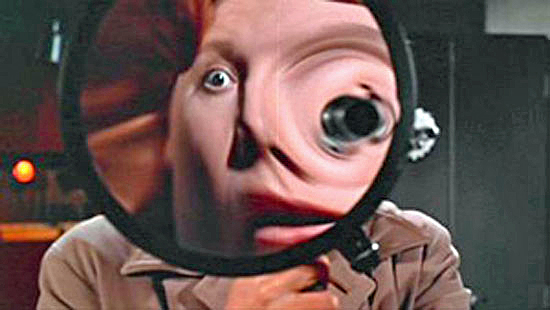Peeping Tom (1960)

DIRECTOR: Michael Powell
CAST: Carl Boehm, Anna Massey, Maxine Audley, Moira Shearer
REVIEW:
Coming out only months before Alfred Hitchcock’s Psycho, Michael Powell’s Peeping Tom narrowly beat it out for staking a claim to fame as the original founder of the slasher movie genre (although by modern standards, or even the standards of the likes of Halloween or Friday the 13th in the next decade, there’s precious little “slashing”). One has to remember the year of its release; for a movie that feels exceedingly tame in its usually implied violence today, it was shocking and controversial at the time. It’s also strange to consider that Psycho, which premiered only months later and had even more depraved subject matter, was a huge hit and acclaimed, while Peeping Tom was a notorious flop that was pulled from theaters, virtually ended its director’s career, and was savaged by the British press. Critics seemed to be in a competition for the most hyperbolic and pearl-clutching condemnations. Derek Hill, reviewer of Tribune magazine, stated colorfully that “the only really satisfactory way to dispose of Peeping Tom would be to shovel it up and flush it swiftly down the nearest sewer. Len Mosley, writing for the Daily Express, stated even more hyperbolically that the film was “more nauseating and depressing than the leper colonies of East Pakistan, the back streets of Bombay, and the gutters of Calcutta”. Such was the scorn leveled at the film that star Carl Boehm later recalled that no one at the premiere wanted to shake his or his director Powell’s hand. However, in following decades the film eventually earned a more favorable critical reappraisal as an ahead-of-its-time psychological horror thriller and gained prominent admirers like Martin Scorsese, who praised the film in writings and even chipped in $5,000 to help the relatively obscure and forgotten film find a wider audience with a 1978 re-release.
We open with an appropriately voyeuristic shot through a camera lens as the unseen killer zeroes in on his latest unsuspecting victim. Though we don’t see him right away, he is Mark Lewis (Carl Boehm), a seemingly shy and mild-mannered photographer who works at a film studio as his day job and moonlights taking pornographic pictures his shopkeeper boss is selling to eager customers on the side. Occasionally he also moonlights as a psychotic murderer with a hidden blade in his tripod, who pores over the films he makes of his victims’ terrified final moments in the dark room in his apartment. Mark is a reclusive hermit, but the chipper girl downstairs, Helen (Anna Massey) hopes to change that. Her blind mother (Maxine Audley) disapproves. She senses there’s something “off” about Helen’s new friend. And indeed there is, as Mark’s budding romance with Helen might put the unsuspecting girl on a collision course with his darker impulses.
While there’s a skeletal framework of a narrative—-Mark’s budding romance with Helen, suspense over when he’ll strike again, and cops snooping around after a murder on his film set—-it’s thinly-developed and primarily serves as a vehicle for a character study of a deeply disturbed individual. It’s interesting to note a couple similarities between Mark Lewis and the much better-known, iconic madman who followed him a few months later, Anthony Perkins’ Norman Bates. Both are outwardly shy, socially awkward, boyishly handsome men who are also vicious killers. Both were shaped into monsters by a monstrous parent, Norman by his mother, and Mark by his scientist father, who terrorized the boy throughout his childhood—-and obsessively filmed and documented all of it—-as experiments into children’s responses to fear. As Norman is consumed by his mother, so is Mark unhealthily attached to the camera he carries everywhere like an extra limb. When Helen kisses him, the most response the emotionally repressed man can muster is a tender kiss onto the lens of his camera. Like Norman Bates, we can find Mark Lewis something of a tragic figure, wounded and deeply damaged. At the same time, there’s tension about when he’ll strike again, never more so than in an extended sequence that one could imagine Hitchcock directing, where he entices an extra (Moira Shearer) to have a secret rendezvous on set after hours so he can film her dancing. Delighted to get her moment in the spotlight, she dances around the set and even into the big blue trunk where her body is found the next day. There’s also suspenseful moments with Helen and her mother, who is not afraid to confront Mark, even showing up unannounced and uninvited in his dark room one day, although she cannot see the film being played in front of her (“what am I seeing, Mark?”). His budding relationship with Helen brings out his tentative damaged humanity, but how long can it last?

At one point, Powell apparently considered casting Laurence Harvey in the lead role. Instead, the cast was filled out with lesser-known names. The lead went to Karlheinz Böhm (credited as Carl Boehm), well-known in Germany and Austria for co-starring with Romy Schneider as Emperor Franz Joseph I in the historical romance Sissi film trilogy but in his English-language debut (speaking with a clear German accent despite being given the generically British name of “Mark Lewis”). Boehm makes an intriguingly conflicted and contradictory Mark, soft-spoken and boyishly handsome, equal parts a shy awkward wounded man and a creepy homicidal voyeur. The most significant supporting character is Anna Massey’s naively chipper Helen (Massey would later appear in the 1972 Hitchcock thriller Frenzy as a barmaid who becomes involved with a suspected killer), but the most interesting is Maxine Audley as her mother, a blind alcoholic with sharp instincts (how does she know Mark is peeping in their window? “The hair on my neck stood up”). The scene where she confronts Mark—-and tension abounds over what he’s going to do about it—-is one of the movie’s standouts.

Maybe part of what made people uncomfortable at the time—-consciously or unconsciously—-is the way it draws us into seeing through the voyeuristic viewpoint of the killer. The opening shot is through his viewfinder, and we later return to the same footage in Mark’s dark room, the victim’s terrified face imposed onto the back of Mark’s head. In a bit of blurring the lines between fact and fiction—-and perhaps making a statement about the voyeuristic nature of directing—-director Michael Powell casts himself as Mark’s father the obsessive documentarian, his wife as Mark’s dying mother, and his son as child Mark.
Anyone who grew up on the likes of Halloween or Friday the 13th in the following decade—-or the ever more graphic and bloody slasher movies ever since—-who goes back to check out Peeping Tom intrigued by its description as the originator of the slasher genre might be in for disappointment. The horror here is far more psychological than physical; the violence is more implied than shown, and there’s nary a drop of blood. But in its ahead-of-its-time psychological character study, the movie is still capable of suspenseful and uncomfortable moments.
* * *